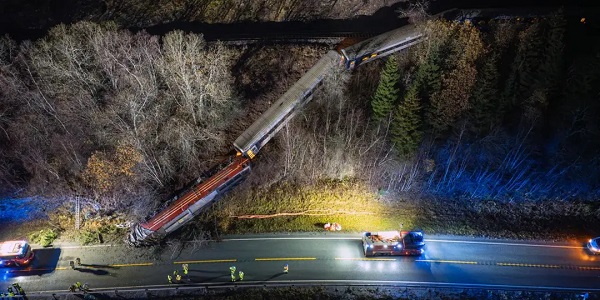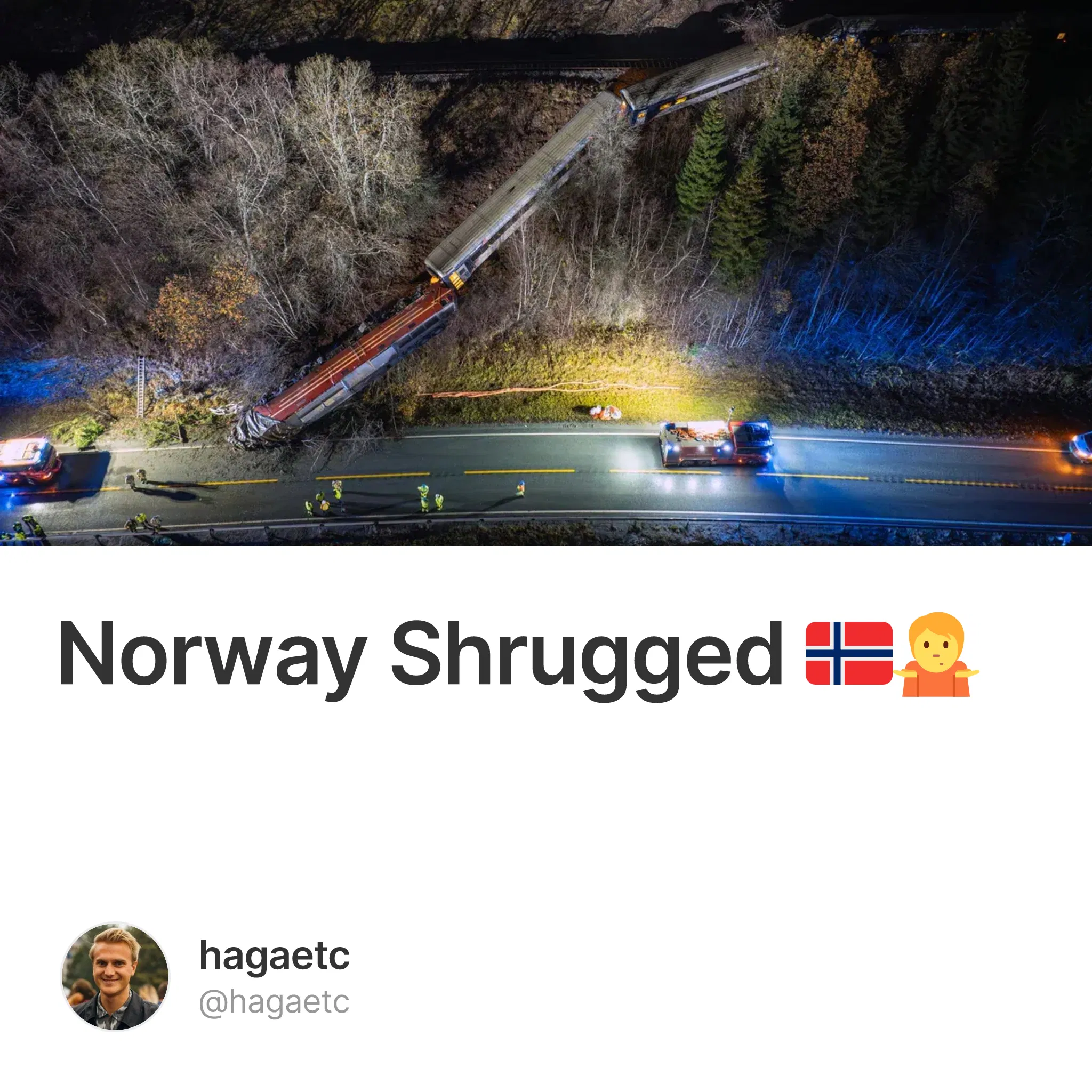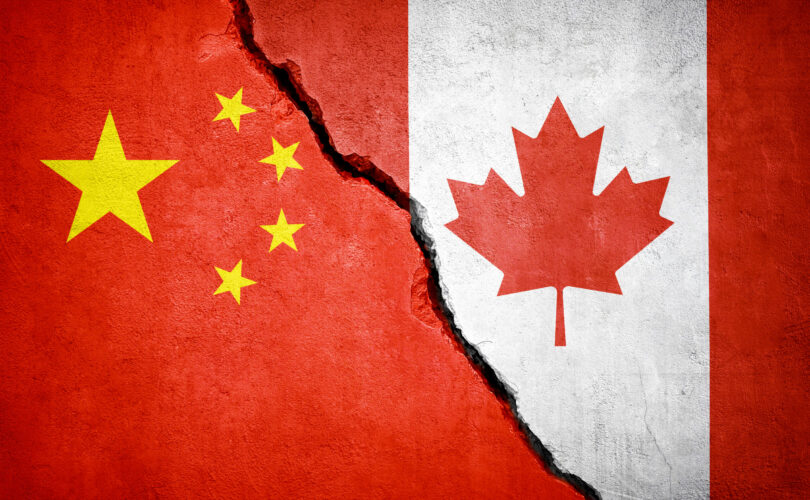Business
Norway’s Trainwreck – How Taxing Unrealized Gains Has Caused an Entrepreneurial Exodus

From hagaet the substack of Fredrik Haga, co-founder of Dune
Norway Shrugged
Recently, my story as a Norwegian entrepreneur facing an unrealized gains wealth tax bill many ties higher than my net income went viral, amassing over 100 million views on X. A few years ago I publicly called out that this tax is both impossible-to-pay and nonsensical, but no politician would listen. So I made the difficult decision to leave my home country. I still don’t know how I was supposed to pay the tax, but I recently found myself plastered on the “Wall of Shame” at the Socialist Left Party’s offices.
In this post, I’ll delve into why there’s an entrepreneurial exodus from Norway, how we got here, and what the future might hold.

Socialist Left leader and me on the “Wall of Shame” (Dagbladet)
Norway: A real life Atlas Shrugged
Ayn Rand’s 1957 novel Atlas Shrugged paints a vivid picture of a dystopian society where government overreach and socialist policies kill innovation and demonize entrepreneurs. In Rand’s world, working hard and taking risks is not celebrated, but looked at with suspicion. As the government tightens its grip, mandating how businesses should operate, the nation’s entrepreneurs begin to vanish and are nowhere to be found. People get poorer while the state keeps growing. Step by step the functioning of society starts to crumble. The trains first go off schedule, then start crashing and eventually stop going all together.
Present-day Norway mirrors this dystopia in unsettling ways. Taking risk with your own money, working hard and then making a profit is frowned upon. While politicians spending the people’s money on non-viable green projects, and delivering dysfunctional public services at high costs has the moral high ground. The government is spending 35 Billion NOK on offshore wind that industry experts think is financially unviable. This is about the same amount as the total wealth tax revenues. Norway spends 45% more than Sweden on health care per capita with approximately the same health outcomes. Norway has 2,5 times bigger share of the working population on sick leave than Denmark. Norway spends ~50% more than Finland on primary and secondary school with worse results.
With unshakeable ideological conviction, socialist politicians are rapidly undermining Norway’s wealth creation. They’re imposing taxes that explicitly disadvantage Norwegian business owners, and are often straight up impossible to pay. When confronted with the reality that you can’t pay taxes with money you don’t have—or that loss-making businesses can’t afford massive dividends just to cover owners’ wealth taxes—the response is vague moralism like “Those with the broadest shoulders must bear the heaviest burdens.” Any argument against any part of the system is by default invalid because there’s free health care…
Norway’s entrepreneurs are now indeed disappearing from society. In the past two years alone, a staggering 100 of Norway’s top 400 taxpayers, representing about 50% of that group’s wealth, have fled the country to protect their businesses.
Norwegian trains have for a long time been notoriously unreliable – even less reliable then in war time Ukraine! In chilling similarity to Atlas Shrugged there’ve been two train crashes, including one fatal, in the last month alone.

Tram crashing into a retail store in Oslo 29th of October 2024 (NRK)
The Unrealized Gains Wealth Tax: A Self-Inflicted Wound
Norway imposes a wealth tax that taxes unrealized gains at approximately 1% annually. Calculated on the full market value for publicly traded assets and the book value of private companies. On New Year’s Eve, whatever your net worth – including illiquid assets – is subject to this tax. It doesn’t matter if you’re running a loss-making startup with no cash flow, if your investments have tanked after the valuation date, or even if your company has gone bankrupt—you still owe the tax.
This creates a perverse scenario where business owners must extract dividends or sell shares every year just to cover their tax bill. With dividend and capital gains taxes at around 38%, you need to withdraw approximately 1.6 million NOK to pay a 1 million NOK wealth tax bill. You’re essentially paying taxes to pay taxes, draining capital from your business without any personal financial gain.
Moreover, the tax incentivizes Norwegians to take on excessive debt to reduce their taxable wealth, inflating housing prices and making the economy more fragile. While real estate and oil companies can mitigate this through debt financing, tech startups—often equity-financed and loss-making for years—are disproportionately harmed.
The Berlin Wall Exit Tax: Another Tax on Unrealized Gains
After witnessing a mass exodus of top taxpayers, the Norwegian government had a golden opportunity to reassess its policies. The wealth tax contributes less than 2% to the state budget; eliminating it and marginally increasing capital gains, corporate, or dividend taxes could have halted the entrepreneurial bleeding without affecting government budgets.
Instead, the government doubled down on what’s not working, introducing an exit tax on unrealized gains. Now, if you choose to move from Norway, you’re immediately liable to pay 38% of the total market value of your assets upon departure. It doesn’t matter if you have no liquidity, if your assets are high-risk and could plummet in value, or even if your company does fail after you leave—you still owe the tax. Previously, entrepreneurs could at least relocate if the wealth tax became too burdensome. Now, they’re incentivized to leave before they even start their businesses.
The government could have listened to the tornado of negative feedback and adjusted course, but instead, they doubled down on what’s not working. When the Berlin wall was created it was clear which side of the city had the better system… the one that didn’t have to build a wall to retain its citizens. Instead of trying to attract and retrain capital and talent by making Norway a better place for business the Norwegian government chose to build its very own Berlin Tax Wall with yet another tax on unrealized gains. Trapping not only entrepreneurs, but anyone with more than $270k of wealth wanting to move their life abroad for whatever reason…
The first 50 years: Well Managed Oil Wealth
Norway is one of the richest countries in the world. The government does not need to send their entrepreneurs abroad with non-sensical taxes. So you may ask yourself, “Well, how did we get here?”.
In fact, the oil wealth has been amazingly well managed by the politicians for almost half a century. In 1969, Norway struck oil—a discovery that could have led to the same resource curse that plagued other nations. Instead, Norwegian politicians made two genius decisions that benefited the entire population.
- Genius Move 1: Taxing Oil Profits at 80%Recognizing the need for foreign expertise but unwilling to let international corporations reap all the benefits, Norway taxed oil company profits at a staggering 80%. This bold move ensured that the wealth generated from the oil benefited the Norwegian people.
- Genius Move 2: Establishing the Sovereign Wealth FundIn the 1990s, Norwegian politicians understood that oil is a finite volatile resource and that it would be irresponsible to spend all the oil revenue on a running basis. In an act of rare political austerity and long term thinking they created the Oil Fund, to diversify and invest surplus revenues internationally. Furthermore the “Budgetary Rule” limited annual government spending from the fund to 3%, ensuring the fund in theory goes on forever.
For two decades, politicians across the spectrum adhered to this prudent financial management, displaying an impressive level of restraint and foresight rarely seen in politics.
How Oil Wealth Led to Socialist Ideology over Wealth Creation
But success bred complacency. In theory, everybody agrees that Norway needs new post-oil industries for the long term. In practice, the abundance of oil wealth has led to a detachment from the realities of how wealth and economic growth is created. While the Norwegian politicians impressively managed to restrain themselves for about half a century the current generation are now acting as if tax money grows on trees.
Ultimately that is the paradox that has caused the current situation: because the state has so much money, it is no longer at the mercy of businesses actually being created and staying in Norway. At least as long as the oil wealth lasts.
The 2025 Election: No Fundamental Solution in Sight
It seems likely there will be a new government after the 2025 elections, as the current government is seeing record-low support in the polls. Unfortunately, even seemingly business friendly opposition parties like the Conservative Party (Høyre) and the Liberals (Venstre) are not committed to abolishing the wealth tax entirely. They propose valuing companies zero for wealth tax purposes—a good step in the right direction, but not a fundamental solution to Norway’s ongoing crisis. Unfortunately The Progress Party (Fremskrittspartiet) is the only party that wants to remove the tax completely.
The wealth tax’s mere existence continues to create absurd incentives for excessive debt and over-investment in housing, detracting from more productive investments like stocks and startups. Moreover, the possibility of future governments reinstating the wealth tax for companies keeps the harmful uncertainty for businesses very much alive.
Many European countries have recognized the harm caused by taxing unrealized gains and abandoned it. Norway’s neighbor Sweden abolished its wealth tax in 2007. Since then they’ve seen its tech sector flourish. Spotify recently surpassed Norway’s state-owned oil company, Equinor, in market capitalization. In the last 15 years Norway has gone from having 7 to now only 2 of the Nordics top 30 most valuable companies.
Norway has produced four “unicorns”. Since then we the founders of Dune and Cognite have left due to the unreasonable taxes. Oda operates domestically in Norway. All founders have left the company and are wiped out. The last one Gelato is run by a swede that would likely move if they need to raise more money.
The Extra Long Journey to Post-Oil Wealth and Welfare
In Atlas Shrugged, the entrepreneurs refuse to return to society until the oppressive system collapses entirely. I sincerely hope Norway doesn’t have to endure such a downfall before entrepreneurs can return.
Fortunately Norway has a highly educated population and a lot of capital. With oil a high tech industry has been built in Norway before. What’s lacking is the political will to encourage entrepreneurship and big ambitions, not punish it.
Trust is built in millimeters and torn down in meters. In just a few years, the trust in Norway as a viable place to build and invest has been shattered. A whole generation of entrepreneurs has been lost.
The people of Norway currently enjoy and benefit from a host of generous welfare benefits. High income with short work days, free healthcare, free daycare, free education and beyond. For this to continue in the future Norway needs massive new post-oil industries. Due to the politicians’ series of unforced errors, the journey to get there will be extra long and painful. A definitive abolishment of all taxes on unrealized capital gains is the obvious first step.

Business
Warning Canada: China’s Economic Miracle Was Built on Mass Displacement

If you think the CCP will treat foreigners better than its own people, when it extends its power over you, please think again: Dimon Liu’s warning to Canadian Parliament.
Editor’s Note: The Bureau is publishing the following testimony to Canada’s House of Commons committee on International Human Rights from Dimon Liu, a China-born, Washington, D.C.-based democracy advocate who testified in Parliament on December 8, 2025, about the human cost of China’s economic rise. Submitted to The Bureau as an op-ed, Liu’s testimony argues that the Canadian government should tighten scrutiny of high-risk trade and investment, and ensure Canada’s foreign policy does not inadvertently reward coercion. Liu also warns that the Chinese Communist Party could gain leverage over Canadians and treat them as it has done to its own subjugated population—an implied message to Prime Minister Mark Carney, who has pledged to engage China as a strategic partner without making that position clear to Canadians during his election campaign.
OTTAWA — It is an honor to speak before you at the Canadian Parliament.
My testimony will attempt to explain why China’s economic success is built on the backs of the largest number of displaced persons in human history.
It is estimated that these displaced individuals range between 300 to 400 million — it is equivalent to the total population of the United States being uprooted and forced to relocate. These displaced persons are invisible to the world, their sufferings unnoticed, their plights ignored.
In 1978, when economic reform began, China’s GDP was $150 billion USD.
In 2000, when China joined the WTO, it was approximately $1.2 trillion USD.
China’s current GDP is approximately $18 trillion USD.
In 2000 China’s manufacturing output was smaller than Italy’s.
Today it’s larger than America, Europe, Japan, and South Korea combined.
If you have ever wondered how China managed to grow so fast in such a short time, Charles Li, former CEO of the Hong Kong Stock Exchange, has the answers for you.
He listed 4 reasons: 1) cheapest land, 2) cheapest labor, 3) cheapest capital, and 4) disregard of environmental costs.
“The cheapest land” because the CCP government took the land from the farmers at little to no compensation.
“The cheapest labor,” because these farmers, without land to farm, were forced to find work in urban areas at very low wages.
The communist household registration system (hukou 戶口) ties them perpetually to the rural areas. This means they are not legal residents, and cannot receive social benefits that legal urban residents are entitled. They could be evicted at any time.
One well known incident of eviction occurred in November 2017. Cai Qi, now the second most powerful man in China after Xi Jinping, was a municipal official in Beijing. He evicted tens of thousands into Beijing’s harsh winter, with only days, or just moments of notice. Cai Qi made famous a term, “low-end population” (低端人口), and exposed CCP’s contempt of rural migrants it treats as second class citizens.
These displaced migrant workers have one tradition they hold dear — it is to reunite with their families during the Chinese Lunar New Year holiday, making this seasonal migration of 100 to 150 million people a spectacular event. In China’s economic winter of 2025 with waves of bankruptcies and factory closures, the tide of unemployed migrant workers returning home to where there is also no work, and no land to farm, has become a worrisome event.
Historically in the last 2,000 years, social instability has caused the collapse of many ruling regimes in China.
“The cheapest capital” is acquired through predatory banking practices, and through the stock markets, first to rake in the savings of the Chinese people; and later international investments by listing opaque, and state owned enterprises in leading stock markets around the world.
“A disregard of environmental costs” is a hallmark of China’s industrialization. The land is poisoned, so is the water; and China produces one-third of all global greenhouse gases.
Chinese Communist officials often laud their system as superior. The essayist Qin Hui has written that the Chinese communist government enjoys a human rights abuse advantage. This is true. By abusing its own people so brutally, the CCP regime has created an image of success, which will prove to be a mirage.
If you think the CCP will treat foreigners better than its own people, when it extends its power over you, please think again.
The Bureau is a reader-supported publication.
To receive new posts and support my work, consider becoming a free or paid subscriber.
Business
Judge Declares Mistrial in Landmark New York PRC Foreign-Agent Case

U.S. District Judge Brian Cogan declared a mistrial Monday afternoon in the high-profile foreign-agent and corruption case against former New York state official Linda Sun and her husband Chris Hu, after jurors reported they were hopelessly deadlocked on all 19 counts.
After restarting deliberations Monday morning with an alternate juror, the panel sent a note to Judge Cogan stating:
“Your honor, after extensive deliberations and redeliberations the jury remains unable to reach a unanimous verdict. The jurors’ positions are firmly held.”
Cogan brought the jury into court and asked the foreman whether they had reached agreement on any counts. They replied that they were deadlocked on every one. The judge then declared a mistrial.
Assistant U.S. Attorney Alexander Solomon immediately told the court that the government intends to retry the case “as soon as possible.” A status conference is scheduled for January 26, 2026, to determine next steps.
Jury selection began November 10, 2025, and the government called 41 witnesses to the stand, compared with eight for the defense and one rebuttal witness for the prosecution. Deliberations began on December 12, and by this afternoon the jurors had sent three notes to the court — each indicating deadlock.
As The Bureau reported in its exclusive analysis Friday, the panel’s fracture had become visible as jurors headed into a second week of deliberations in a landmark foreign-agent and corruption trial that reached into two governors’ offices — a case asking a jury of New Yorkers to decide whether Sun secretly served Beijing’s interests while she and Hu built a small business and luxury-property empire during the pandemic, cashing in on emergency procurement as other Americans were locked down.
Prosecutors urged jurors to accept their account of a dense web of family and Chinese-community financial transactions through which Sun and Hu allegedly secured many millions of dollars in business deals tied to “United Front” proxies aligned with Beijing. The defense, by contrast, argued that Sun and Hu were simply successful through legitimate, culturally familiar transactions, not any covert scheme directed by a foreign state.
Sun and Hu face 19 charges in total, including allegations that Sun acted as an unregistered foreign agent for the People’s Republic of China; visa-fraud and alien-smuggling counts tied to a 2019 Henan provincial delegation; a multimillion-dollar pandemic PPE kickback scheme; bank-fraud and identity-misuse allegations; and multiple money-laundering and tax-evasion counts.
Prosecutors have argued that the clearest money trail ran through New York’s COVID procurement scramble and a pair of Jiangsu-linked emails. In closing, Solomon told jurors that Sun’s “reward” for steering contracts was “millions of dollars in kickbacks or bribes,” contending the money was routed through accounts opened in Sun’s mother’s name and via friends and relatives.
The government has tied those claims to a broader narrative — laid out in Solomon’s summation and dissected in The Bureau’s reporting — that Sun functioned as a “trusted insider” who repurposed state access and letterhead to advance Beijing’s priorities, including by allegedly forging Governor Kathy Hochul’s signature on invitation letters used for Chinese provincial delegations, while keeping those relationships hidden from colleagues. The defense, in turn, urged jurors to reject the government’s picture of clandestine agency and argued prosecutors had overreached by treating ordinary diaspora networking, trade promotion, and pandemic procurement as criminal conduct — insisting none of the evidence proved the “direction or control” element central to the Foreign Agents Registration Act.
Whether a future jury will see the same evidence as corruption and covert foreign agency or as culturally familiar commerce and politics — will now be tested again, on a new timetable, in a courtroom that has already shown just how difficult this record is to unanimously interpret.
The Bureau is a reader-supported publication.
To receive new posts and support my work, consider becoming a free or paid subscriber.
-

 Agriculture21 hours ago
Agriculture21 hours agoWhy is Canada paying for dairy ‘losses’ during a boom?
-

 Automotive1 day ago
Automotive1 day agoFord’s EV Fiasco Fallout Hits Hard
-

 Alberta22 hours ago
Alberta22 hours agoAlberta’s new diagnostic policy appears to meet standard for Canada Health Act compliance
-

 Censorship Industrial Complex23 hours ago
Censorship Industrial Complex23 hours agoTop constitutional lawyer warns against Liberal bills that could turn Canada into ‘police state’
-

 espionage2 days ago
espionage2 days agoCarney Floor Crossing Raises Counterintelligence Questions aimed at China, Former Senior Mountie Argues
-

 International2 days ago
International2 days agoOttawa is still dodging the China interference threat
-

 Health2 days ago
Health2 days agoAll 12 Vaccinated vs. Unvaccinated Studies Found the Same Thing: Unvaccinated Children Are Far Healthier
-

 Business2 days ago
Business2 days agoTaxing food is like slapping a surcharge on hunger. It needs to end









